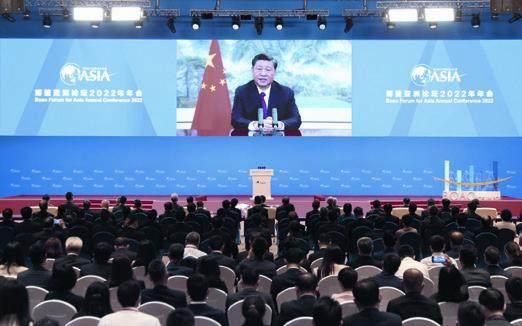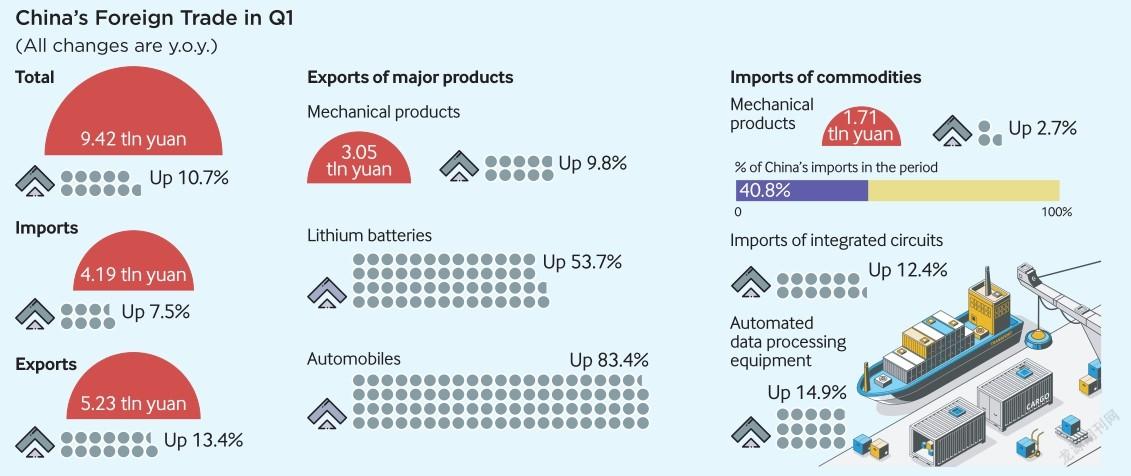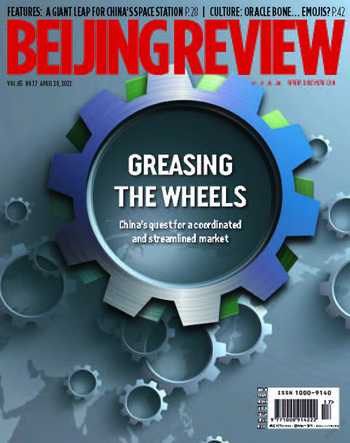DYNAMIC AND DRIVEN

President Xi Jinping delivers a keynote speech via video link during the opening ceremony of the Boao Forum for Asia Annual Conference 2022 on April 21.
The Chinese economy will provide great dynamism for the stability and recovery of the global economy and broader market opportunities for all countries, Xi said.
He said no matter how the world will change, Chinas faith in and commitment to reform and opening up will not waver.
Field to Be Green
Workers plant trees at an eco-tourism area in Dalad Banner, Inner Mongolia Autonomous Region, on April 18.

Supportive Policies
Major cities in the Yangtze River Delta have rolled out a series of measures to alleviate the cash crunch faced by small and micro enterprises caused by the recent COVID-19 resurgence, Xinhua News Agency reported on April 18.
Fiscal policies such as tax and fee reductions, an extension of the deadline for filing tax returns, and rent concessions have been introduced for tens of thousands of private enterprises and individual entrepreneurs.
The policies are clear-cut in terms of measures concerning finance, logistics and information to support the recovery of the retail industry, and involve responsible government depart- ments for the convenience of enterprises, said Ding Zuohong, Chairman of the board of directors of Yuexing Group in Shanghai.
Preliminary estimates show that tax-related measures taken by Shanghai could reduce the burden on related industries and enterprises by approximately 140 billion yuan ($22 billion) in 2022.
At least three major cities in the Yangtze River Delta—Shanghai, Hangzhou and Suzhou—have issued policies to facilitate financing guarantees, provide interest rate subsidies, and guide financial institutions to grant more loans for small and micro enterprises in an effort to alleviate financial strains.
Benefiting from targeted measures for the services in- dustry, which has been severely impacted by the pandemic, sectors such as food and beverage, retail, tourism, transportation and exhibitions have seen an improving environment for financing.
Authorities in Zhejiang Province will provide free regular nucleic acid testing for employees of food and beverage business, and accept deferred payments of unemployment insurance premiums for eligible retail enterprises. Hangzhou, the provincial capital, will partially exempt public transportation service providers from valueadded tax.
Shanghai has encouraged government-backed financing guarantee institutions to provide credit support for travel agencies, and it has been considering sub- sidies for the exhibitions industry.
A Task for Talent
Shenzhen, a technological powerhouse in Guangdong Province, saw 27,000 Chinese students return from overseas to settle down locally last year, an increase of over 30 percent year on year and marking a record high, according to the municipal human resources and social security bureau, Xinhua reported on April 13.
The city, home to a bevy of Chinese startups and tech heavyweights including Huawei and Tencent, is an attractive choice for job seekers because of its fast-developing industries such as software and information technology services, finance, education and manufacturing.
The returned students who gained residency in Shenzhen in 2021 had graduated from universities in nearly 60 countries and regions around the world. The average age of the cohort is approximately 27, with over 95 percent aged under 35 and over 80 percent holding a masters degree or higher.
Relics Protection
More than 1.1 million folios of 3,281 ancient books and documents have been archived at the Potala Palace in Tibet Autonomous Region over the past three years, Xinhua reported on April 18.
The progress was announced at a relics protection conference in the region, following completion of the first phase of a 10-year project that began in late 2018. The project aims to protect ancient texts at the palace and has a total investment of 300 million yuan($47 million).
The Potala Palace, located in the regional capital of Lhasa, was built by Tibetan King Songtsen Gampo in the seventh century and was expanded in the 17th century.
The palace was included on the UNESCO World Heritage List in 1994 and holds a collection of invaluable scriptures, historical documents, and precious relics, including statues, paintings and frescoes.
The palace collection includes tens of thousands of ancient books and documents in Chinese, Tibetan, Manchu, Mongolian and Sanskrit.
Back in Business
An employee at an auto parts factory in Jilin City, Jilin Province, on April 19. Local enterprises have been resuming production under strict COVID-19 prevention and control measures.

Grand Canal Refilled
The Grand Canal, a vast waterway connecting northern and southern China, is set to see all of its empty sections refilled with water this year as a water-supply project kicked off on April 14.
Launched by Beijing, Tianjin, Hebei and Shandong—four of the regions the canal flows through—it is estimated this project will inject 515 million cubic meters of water into the northern part of the canal, according to the Ministry of Water Resources.
The water will primarily come from some sections of the Southto-North Water Diversion Project, recycled water and accumulated rainwater, the Ministry said.
Once completed, this project is expected to increase the water surface area of the Grand Canal by 9.5 square km from a year earlier, the Ministry said, adding that this will help improve the ecosystems along the canal.
With a history spanning 2,500 years, the Grand Canal connects Beijing and Hangzhou in Zhejiang Province, and served as a significant transportation artery in ancient China. The longest and oldest artificial waterway in the world, the Grand Canal is a UNESCO World Heritage site.
Due to historical evolution, human activities and climate change, some sections of the canal began to dry up in the first half of the 20th century.
Fraud Crackdown
Chinas top court has ordered a nationwide campaign to crack down on fraud against senior citizens, especially fraud related to aged care, Xinhua reported on April 18.
The Supreme Peoples Court(SPC) said that courts nationwide should more severely punish criminals committing these crimes.
The SPC also asked courts to take all possible measures to retrieve the proceeds of these crimes and to minimize victims losses.
The top court added that more publicity efforts are needed to raise awareness of the tricks commonly used by these criminals.
Stocking Up
Employees at a farm in Chongming District, Shanghai, transfer packaged vegetables to be sent to urban areas on April 19. Vegetable production and processing enterprises in the district have been making efforts to assure the vegetable supply to urban areas amid the recent COVID-19 resurgence in the metropolis.

Afforestation Drive
China Forestry Group Corporation said on April 16 that it will strive to plant 40,267 hectares of trees in the country in 2022.
The company, the only centrally administered stateowned forestry enterprise , raked in 1.28 billion yuan ($200 million) in profits in 2020, up 64.7 percent from the previous year.
China planted 3.6 million hectares of forest and converted 380,800 hectares of farmland into forest in 2021, and took targeted measures to improve the quality of forests, restoring 933,300 hectares of degraded forest over the same period.
New Legislation
A law on futures and derivatives was adopted at a session of the Standing Committee of the National Peoples Congress, Chinas top legislature, on April 20. It will take effect on August 1.
Financial institutions should obtain approvals, fulfill tradersduties of suitability management and observe relevant regulations when conducting derivatives trading, according to the new legislation.
The law also clarifies rules on swap and forward contracts.
Overseas institutions should obtain approvals from futures regulatory authorities under the State Council before engaging in futures marketing, promotion and solicitation activities in China, it stipulates.
Chinas futures market posted record-setting trading volume and turnover in 2021, which stood at 581.2 trillion yuan($90.8 trillion) and over 7.5 billion lots, respectively, data from the China Futures Association showed.
NEV Support
Measures will be rolled out to bolster the new-energy vehicle(NEV) industry, including extending the preferential policy for purchase tax, the Ministry of Industry and Information Technology said on April 19.
The country will continue to pilot new NEV battery-swapping models amid efforts to stabilize the industrial and supply chains, Luo Junjie, an official with the Ministry, told a press conference.
Chinas NEV sector is likely to maintain a rapid pace of expansion in 2022, according to Luo.
Nevertheless, it also faces challenges such as COVID-19 flare-ups, price hikes in raw materials, and auto chip shortages.
To help NEV manufacturers address these challenges, the Ministry will formulate a roadmap for the low-carbon de- velopment of the auto industry, encourage the integration of auto electrification and intelligent technologies, and improve the safety of NEV batteries and their adaptation to low temperatures, according to Luo.
It will also speed up the domestic exploitation of NEVrelated resources and cooperate with other authorities in cracking down on hoarding and price gouging to bring raw material prices “back to a reasonable level,” Luo added.
In the first three months of this year, Chinas retail sales and output of NEVs amounted to roughly 1.26 million units and 1.29 million units, respectively, both seeing a 140-percent surge from a year earlier, data from the Ministry showed.
Tax Refunds
Value-added tax (VAT) credit refunds topped 420.2 billion yuan ($65.9 billion) in the first half of April, data from the State Taxation Administration showed on April 19.
The refunds benefited 527,000 taxpayers, according to the administration.
Tax refunds and cuts are expected to total 2.5 trillion yuan($390.7 billion) nationwide this year, while VAT credit refunds will account for 1.5 trillion yuan($234.4 billion) of the sum and will all go straight to enterprises, according to this years government work report.
R&D Spending
Centrally administered stateowned enterprises (SOEs) increased their spending on research and development (R&D) to boost innovation-driven development in the first three months of 2022, according to the State-Owned Assets Supervision and Administration Commission of the State Council on April 19.
Their total investment expanded 18.9 percent year on year to 151.42 billion yuan ($23.76 billion), the commission said.
The operating profit margin of central SOEs stood at 6.8 percent during the months, flat with the same period last year.
The data also showed that production efficiency of the companies increased steadily. Their annualized total labor productivity was 727,000 yuan($113,630) per capita in the first three months, a year-on-year increase of 13 percent.
In the first quarter, the companies raked in 9 trillion yuan ($1.4 trillion) in combined revenues, up 15.4 percent year on year. Their net profits grew 13.7 percent to 472.33 billion yuan($73.8 billion).
Interbank Bonds
By late March, bonds in Chinas interbank market held by overseas institutions reached 3.88 trillion yuan ($607.24 billion), according to a report released by the Peoples Bank of China Shanghai Head Office.
The figure represented a drop of 110 billion yuan ($17.2 billion) month on month.
In March, nine new overseas institutional investors entered the market, bringing the total number to 1,034, the report showed.
Service Outsourcing
The service outsourcing industry posted a steady expansion during the January-March period, data from the Ministry of Commerce showed.
Chinese firms inked related contracts worth about 488.1 billion yuan ($75 billion), up 10.3 percent year on year.
The executed contract value came in at 318.5 billion yuan($49.8 billion), with a year-onyear increase of 17.2 percent.
Of the total, offshore service outsourcing contract value rose 4.6 percent from a year ago to 264.8 billion yuan ($41.4 billion).
Service outsourcing with members of the Regional Comprehensive Economic Partnership saw quicker growth, with the executed contract value rising 3.2 percent from a year earlier to 38.2 billion yuan ($5.9 billion).
Gas Pipeline
The China-Central Asia Gas Pipeline sent 10.07 billion cubic meters of natural gas to China in the first quarter of the year, according to PipeChina West Pipeline Co.
Last year, the pipelines annual transmission volume totaled about 44.1 billion cubic meters, the company said.
By late March, the pipeline had delivered about 390 billion cubic meters of natural gas to China since it was put into service in December 2009.
With a total length of 1,833 km and a designed annual capacity of 60 billion cubic meters, the project is Chinas first transnational gas pipeline. It begins at the border between Turkmenistan and Uzbekistan, passes through Uzbekistan and Kazakhstan, and links up with Chinas West-to-East Gas Pipeline in Horgas, Xinjiang Uygur Autonomous Region.
Nuclear Power Unit
A new nuclear power unit in Pakistan powered by a Chinadeveloped Hualong One reactor has started commercial operation, the China National Nuclear Corp. said on April 18.
Karachi Unit 3 is the fourth nuclear power unit worldwide use Hualong One technology, a third-generation reactor design. Karachi Unit 2 and Unit 3, both powered by Hualong One reactors, will provide nearly 20 billion kWh of electricity for Pakistan, the corporation said.
The projects construction has also helped boost the local economy and related industries, it added.
Two nuclear power units using Hualong One reactors are operating in China.
NUMBERS
($1=6.4 yuan as of April 21)



